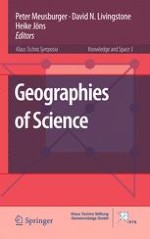2010 | OriginalPaper | Buchkapitel
A Geohistorical Study of “The Rise of Modern Science”: Mapping Scientific Practice Through Urban Networks, 1500–1900
verfasst von : Peter J. Taylor, Michael Hoyler, David M. Evans
Erschienen in: Geographies of Science
Verlag: Springer Netherlands
Aktivieren Sie unsere intelligente Suche, um passende Fachinhalte oder Patente zu finden.
Wählen Sie Textabschnitte aus um mit Künstlicher Intelligenz passenden Patente zu finden. powered by
Markieren Sie Textabschnitte, um KI-gestützt weitere passende Inhalte zu finden. powered by
